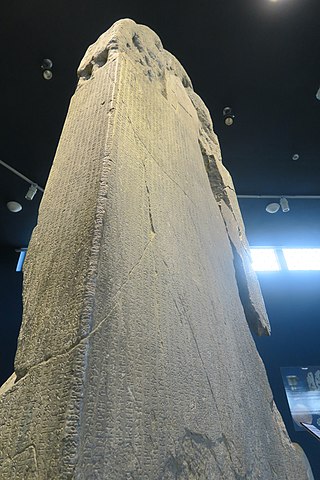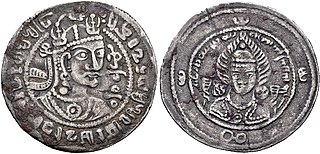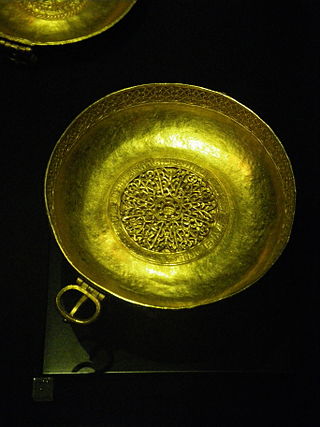Related Research Articles

The Old Turkic script was the alphabet used by the Göktürks and other early Turkic khanates from the 8th to 10th centuries to record the Old Turkic language.

Ï, lowercase ï, is a symbol used in various languages written with the Latin alphabet; it can be read as the letter I with diaeresis, I-umlaut or I-trema.

The Kievan Letter, or Kyivan letter is an early 10th-century letter thought to be written by representatives of the Jewish community in Kiev. The letter, a Hebrew-language recommendation written on behalf of one member of their community, was part of an enormous collection brought to Cambridge by Solomon Schechter from the Cairo Geniza. It was discovered in 1962 during a survey of the Geniza documents by Norman Golb of the University of Chicago. The letter is dated by most scholars to around 930 CE. Some think that the letter dates from a time when Khazars were no longer a dominant force in the politics of the city. According to Marcel Erdal, the letter does not come from Kyiv but was sent to Kyiv.
Tzitzak, baptised Irene, was a Khazar princess, the daughter of khagan Bihar, who became empress by marriage to Eastern Roman Emperor Constantine V.
Khazar, also known as Khazaric, was a Turkic dialect group spoken by the Khazars, a group of semi-nomadic Turkic peoples originating from Central Asia. There are few written records of the language and its features and characteristics are unknown. It is believed to have gradually become extinct by the 13th century AD as its speakers assimilated into neighboring Turkic-speaking populations.
Old Turkic is the earliest attested form of the Common Turkic languages, first found in Second Turkic Khaganate then in Uyghur Khaganate inscriptions. In marked contrast to Middle Turkic, the geographic extent of (East) Old Turkic is rather confined, being limited mainly to East Turkistan and Mongolia. In terms of the datability of extant written sources, the period of Old Turkic can be dated from slightly before 720 AD to the Mongol invasions of the 13th century. Orkhon Turkic and Old Uyghur are considered to be dialects of East Old Turkic, Orkhon Turkic being the earliest attested dialect of (East) Old Turkic. There is a difference of opinion among linguists with regard to Karakhanid Turkic, some classify it as another dialect of East Old Turkic, while others prefer to include Karakhanid among Middle Turkic languages; nonetheless, Karakhanid is extremely close to Old Uyghur so much so that a single grammatical description will fit both of them. East Old Turkic and West Old Turkic together comprise the Old Turkic proper. East Old Turkic is the oldest attested member of the Siberian Turkic branch of Turkic languages, and several of its now-archaic grammatical as well as lexical features are extant in the modern Yellow Uyghur, Lop Nur Uyghur and Khalaj ; Khalaj, for instance, has (surprisingly) retained a considerable number of archaic Old Turkic words despite forming a language island within Central Iran and being heavily influenced by Persian. Old Uyghur is not a direct ancestor of the Modern Standard Uyghur language ; the contemporaneous ancestor of Modern Uyghur was one of the Middle Turkic languages, later giving rise to Chagatai literary language.
The Karluks were a prominent nomadic Turkic tribal confederacy residing in the regions of Kara-Irtysh and the Tarbagatai Mountains west of the Altay Mountains in Central Asia. Karluks gave their name to the distinct Karluk group of the Turkic languages, which also includes the Uzbek, Uyghur and Ili Turki languages.
According to ibn Fadlan, the Jāwashīghar was an official in the Khazar government under the command of the Kündür Khagan, in turn under Khagan Bek's command. Ibn Fadlan did not describe the duties of this officer.

An elteber was a client king of an autonomous but tributary tribe or polity in the hierarchy of the Turkic khaganates including Khazar Khaganate.
Shor is a critically endangered Turkic language spoken by about 2,800 people in a region called Mountain Shoriya, in the Kemerovo Province in Southwest Siberia, although the entire Shor population in this area is over 12000 people. Presently, not all ethnic Shors speak Shor and the language suffered a decline from the late 1930s to the early 1980s. During this period the Shor language was neither written nor taught in schools. However, since the 1980s and 1990s there has been a Shor language revival. The language is now taught at the Novokuznetsk branch of the Kemerovo State University.
I, or ı, called dotless i, is a letter used in the Latin-script alphabets of Azerbaijani, Crimean Tatar, Gagauz, Kazakh, Tatar and Turkish. It commonly represents the close back unrounded vowel, except in Kazakh where it represents the near-close front unrounded vowel. All of the languages it is used in also use its dotted counterpart İ while not using the basic Latin letter I.
Alp Ilutuer was the Ilutuer of the North Caucasian Huns during the 680s CE.
Old Uyghur was a Turkic language which was spoken in Qocho from the 9th–14th centuries as well as in Gansu.

The Treasure of Nagyszentmiklós is an important hoard of 23 early medieval gold vessels, in total weighing 9.945 kg, found in 1799 near Nagyszentmiklós, Kingdom of Hungary, meaning "Great St Nicholas". After the excavation, the treasure was transferred to Vienna, the dynastic capital of the Habsburg Monarchy. Ever since, it has been in the possession of the Kunsthistorisches Museum there, where it is on permanent display.

Irk Bitig or Irq Bitig, known as the Book of Omens or Book of Divination in English, is a 9th-century manuscript book on divination that was discovered in the "Library Cave" of the Mogao Caves in Dunhuang, China, by Aurel Stein in 1907, and is now in the collection of the British Library in London, England. The book is written in Old Turkic using the Old Turkic script ; it is the only known complete manuscript text written in the Old Turkic script. It is also an important source for early Turkic mythology.

The Buyla inscription is a 9-word, 56-character inscription written in the Greek alphabet but in a non-Greek language. It is found on a golden buckled bowl or cup which is among the pieces of the Treasure of Nagyszentmiklós which are now in the Kunsthistorisches Museum in Vienna. The bowl is 12 cm in diameter and weighs 212 g, and has a handle or buckle, perhaps for hanging on a belt. The inscription is found around the outside of a circular design in the middle of the bowl. In the place where the inscription begins and ends, there is a cross. The inscription reads: ΒΟΥΗΛΑ·ΖΟΑΠΑΝ·ΤΕϹΗ·ΔΥΓΕΤΟΙΓΗ·ΒΟΥΤΑΟΥΛ·ΖΩΑΠΑΝ·ΤΑΓΡΟΓΗ·ΗΤΖΙΓΗ·ΤΑΙϹΗ.
Ashina Anluo was the fifth ruler of the Turkic Khaganate. in the sixth century. His regnal title is not recorded in Chinese sources.
Siberian Tatar is a Turkic language spoken in Western Siberia, Russia, primarily in the oblasts of Tyumen, Novosibirsk, Omsk but also in Tomsk and Kemerovo. According to Marcel Erdal, due to its particular characteristics, Siberian Tatar can be considered as a bridge to Siberian Turkic languages.
Orkhon Turkic, is the first stage of Old Turkic, known as the oldest Turkic literary language preceding Old Uyghur. It is generally used for the language in which the Orkhon and Yenisei inscriptions are written.
Claus Schönig was a German Turkologist. His interests included the historical linguistics of the Turkic languages, Altaistics, and Turko-Mongolic relations.
References
- ↑ "Marcel Erdal CV". Hacettepe University. Retrieved 25 August 2012.[ dead link ]